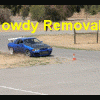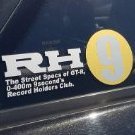Cheap alternative to Z32 Airflow upgrade???
Announcements
-
Similar Content
-
Latest Posts
-
Oh, yeah, no arguing that the duty cycle is different. And a circuit car will go to those speeds for more distance and longer times. But, I suspect that if a tailshaft has a harmonic problem, that it would cause damage and shit itself maybe even on the first pass. A second or two of running at the resonant/harmonic problem speed is already a couple hundred revolutions.
-
By Dose Pipe Sutututu · Posted
Shaft speed would be the same, however it's how long they hold it there for and repeated conditions. FWIW half way down the main straight at SMSP I'm bouncing off 4th with a 8600RPM limiter. That shaft would be spinning at 8600RPM for a few seconds before I need to smash the brakes, by T2 it's getting close to that speed again. Now a drag car/roll race car would see that shaft speed for a 1 to 2 secs then they would coast, hit the brakes and that's it. -
With same diff ratio, tyre diameter and road speed, the tailshaft rpm is the same regardless of the gearbag's ratio. Given that very quick drag cars are probably doing similar road speeds to the fastest circuit cars (circa 300 km/h), and there will be many of either category that can't go that fast and so you'd have inummerable matchups between drag and circuit car speeds at smaller numbers, and given that they are probably using rather similar tyre diameters and probably using similar diff ratios, and...where any of those numbers were different they could quite easily be in opposite directions thus cancelling out.... I think you'd find that there'd be more similarity than difference in tailshaft speed between these two use cases, no?
-
By Dose Pipe Sutututu · Posted
they might see those prop shaft speeds for 1 to 2 secs only -
A year of slogging through this bearing issue and finally fixed. What a nightmare. The oil pressure increase did not fix the problem. If you would like to read all the details in case you ever run into a similar issue visit my thread on Yellow Bullet. https://www.yellowbullet.com/threads/continuous-rod-bearing-issues.2689569/?post_id=74193031&nested_view=1&sortby=oldest#post-74193031 In the end the rod bearings themselves were the issue. I had switched from ACL (first engine) to King because that was all we could get at the time and I thought nothing of it. Put the ACL's back in after a year of taking the pan off multiple times to change many things. Issue resolved. Can't believe it was just the bearings themselves all along. It has now been about two years since I drove the car on the street or had it at the track. At some point I had installed all solid and spherical bushings in the rear but had never aligned it since it just went on and off the dyno. Alignment was the first thing to do. (Old photo but same concept) Then I took the transmission out and went through it. This was my first gearset install and I've done about 15 since this one and learned a lot and wanted to apply some of these tweaks to mine. The aftermarket shift forks take very well to some modification and I wanted to make that change. Shifts are now super smooth and no having to find the gear. I also recut the 5th and reverse shift sleeves - always wanted to try this and see how well it works. It works very well! No grinds or having to do a second attempt going into reverse and 5th is perfect. Before During After Going back in In rummaging through my spare trans parts box I found the only parts I've ever broke on a stock trans; the 3-4 shift fork - twice!
-







Recommended Posts
Create an account or sign in to comment
You need to be a member in order to leave a comment
Create an account
Sign up for a new account in our community. It's easy!
Register a new accountSign in
Already have an account? Sign in here.
Sign In Now